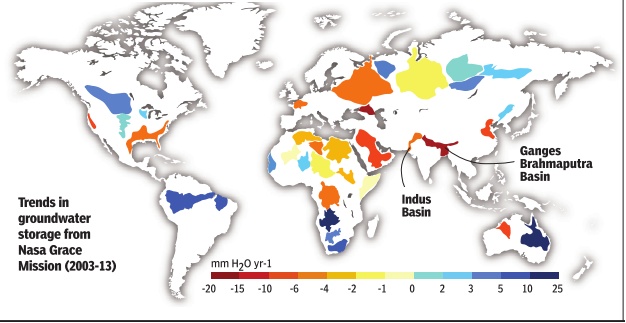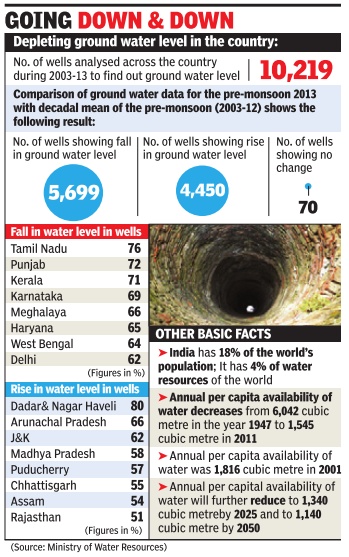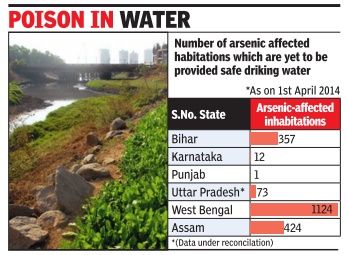Groundwater: India
(→India and the world) |
(→India and the world) |
||
| Line 50: | Line 50: | ||
About 13 of the world's 37 biggest aquifers, including two in India, are being seriously depleted by irrigation and other uses, much faster than they can be recharged by rain or runoff. There were 21 major groundwater basins -in red, orange, and yellow -that lost water faster than they could be recharged between 2003 and 2013.Sixteen major aquifers (in blue) by contrast, gained water during that period. | About 13 of the world's 37 biggest aquifers, including two in India, are being seriously depleted by irrigation and other uses, much faster than they can be recharged by rain or runoff. There were 21 major groundwater basins -in red, orange, and yellow -that lost water faster than they could be recharged between 2003 and 2013.Sixteen major aquifers (in blue) by contrast, gained water during that period. | ||
| + | |||
| + | =March 2016= | ||
| + | [http://epaperbeta.timesofindia.com//Article.aspx?eid=31973&articlexml=Sharp-drop-in-groundwater-level-in-HP-07032016006030 ''The Times of India''], Mar 7, 2016, Mar 07 2016 | ||
| + | |||
| + | Anand Bodh | ||
| + | |||
| + | ''' Sharp drop in groundwater level in HP ''' | ||
| + | |||
| + | Climate change has started ringing alarm bells in Himachal Pradesh as not only rain and snow pattern has been affected, but now groundwater level too has decreased significantly. The groundwater resources occur mainly in unconsolidated sediments of inter-mountain valleys and sub-mountain tract.Kangra, Una, Hamirpur, Bilaspur, Mandi, Solan and Sirmaur districts, particularly valley areas, depend on groundwater for their needs. | ||
| + | Sarkaghat BJP MLA Inder Singh had asked a question during the ongoing budget session about the decreasing groundwater level in the state.He had also sought details of surveys conducted by the irrigation and public health department on the issue, besides steps taken by the department in this regard. | ||
| + | |||
| + | In a written reply, irrigation and public health minister Vidya Stokes informed the house that in many valleys and areas of the state declining trend of groundwater level had been found. She added that the de partment along with Central Groundwater Board had carried dynamic groundwater resource estimation. | ||
| + | |||
| + | To prevent the declining ground water level, the state government has approved detailed project report of about `139 crore to construct 956 rain water conservation structures, she said, adding that already 562 rain water conservation structures have been constructed at a cost of about ` 25 crore. | ||
| + | |||
| + | A report prepared by the Central Ground Water Board has stated that due to extensive groundwater useage for irrigation and the recently set up industrial units in Una valley, the levels are likely to further show depleting trend. There is an urgent need for the state government to initiate water level monitoring network both in shallow and deep aquifers to monitor its behavior on short as well as long term basis, it added. | ||
| + | |||
| + | Studies state that as on March 2011, the stage of groundwater development in Una and Hum valleys of the district was 108% and 99%, respectively, and falls under critical category of development. | ||
| + | |||
| + | There is, thus, no scope for further ground water development by constructing additional wells and tube wells in the area. | ||
| + | |||
| + | Another report on Solan district by Central Ground Water Board said that in many parts availability of water during summer is limited, particularly in hilly areas during drought low rain fall years. There is thus, immediate need to conserve and augment water resources. | ||
| + | |||
| + | It said that presently, large development of ground water is observed in industrial belts of Nalagarh valley, wherein fall of water level down to six meters have been observed in parts. | ||
| + | |||
| + | Thus, depletion in ground water levels and also vulnerability to ground water pollution, are the major issues in this industrial belt. | ||
| + | |||
| + | Report said that in alluvial areas of Nalagarh valley, though there is scope for ground water development, as stage of ground water development is only 52%, however, there is need to adopt cautious approach and phased manner development of ground water in view of depleting water levels in some parts. | ||
| + | |||
| + | This decline can be attributed to fast pace of development in recent years, both in agriculture sector and industrial sector. | ||
=See also= | =See also= | ||
[[Groundwater: India]]/ | [[Groundwater: India]]/ | ||
[[Water Resources: India (ministry data)]]/ [[Water Economy: India]] | [[Water Resources: India (ministry data)]]/ [[Water Economy: India]] | ||
Revision as of 19:51, 20 June 2016
This is a collection of articles archived for the excellence of their content.
|
Contents |
Depleting groundwater
Depleting ground water levels cause for worry
Vishwa.Mohan New Delhi
The Times of India Jul 27 2014
Ground water levels in various parts of India are declining as the country could not adequately recharge aquifers in deficit areas where it has been used for irrigation, industries and drinking water needs of the growing population over the years.
The Central Ground Water Board (CGWB) has told the ministry of water resources that around 56% of the wells, which are analyzed to keep a tab on ground water level, showed decline in its level in 2013 as compared to the average of preceding 10 years (200312) period.
The CGWB, a government agency , came to this conclusion by analyzing 10,219 wells across the country . It found that 5,699 wells had reported decline during that period. It also concluded that agriculture sector is the biggest user of water followed by domestic and industrial sector.
Sharing the Board's data, the ministry of water resources had last week told the Lok Sabha that the ground water was continuously being exploited due to population growth, increased industrialization and irrigation.
“As a result, ground water levels in various parts of the country are declining... The state governments have been advised to take suitable remedial measures to check ground water exploitation and ensure recharge of aquifers in water stressed areas“, said the MoS for water resources, Santosh Gangwar, in his written response to a question.
Depleting ground water level may be a real worry if one looks at the future demand of water in India. It is estimated that the country would need 1,180 billion cubic meter (BCM) of water annually by 2050. India has, at present, annual potential of 1,123 BCM of `utilizable' water with 690 BCM coming from surface water resources and remaining 433 BCM from ground water resources. In view of this projection, the country would not be able to meet its demand unless it recharges its aquifers and uses water more efficiently and judiciously. The government has decided to set up a National Bureau of Water Use Efficiency under its `National Water Mission' to promote water conservation in a big way , keeping in mind the future requirement.
The CGWB has, on its part, recently signed a memorandum of understanding (MoU) with Indian Institute of Remote Sensing to facilitate a collaborative study “to assess the impact of ground water abstraction“ in India.
Arsenic in groundwater
Mohua Chatterjee, December 12, 2014
The parliamentary estimates committee headed by BJP MP Murli Manohar Joshi, in its first report on arsenic in groundwater, has criticized the Centre for “neglecting“ the serious issue that impacts at least 7 crore people across six states, according to CSIR estimates (data from different ministries and departments on the subject varies widely , the committee found). The panel has recommended that the Centre take up the issue on war footing through a national task force that can work on mission-mode from collating date to taking remedial measures to providing for health care to affected people. The committee has suggested that the issue be dealt with at the central level, instead of asking states alone to tackle the problem. Joshi said, “To say water is a state is sue is no logic, given the scale of the problem, the Centre cannot escape its responsibility to provide safe drinking water for 7 crore people, which is their fundamental right.” He was speaking at a press conference after the report was tabled.
The report has recommended that a national task force be set up on a time-bound basis that will work on mission mode on the issue that affects people, plants, animals and all else around it. The committee has also recommended for a central fund allocation for the purpose. At a press conference, Joshi said, the Centre cannot escape its responsibility to provide safe, potable water to 7 crore Indians which is there fundamental right.
India and the world

About 13 of the world's 37 biggest aquifers, including two in India, are being seriously depleted by irrigation and other uses, much faster than they can be recharged by rain or runoff. There were 21 major groundwater basins -in red, orange, and yellow -that lost water faster than they could be recharged between 2003 and 2013.Sixteen major aquifers (in blue) by contrast, gained water during that period.
March 2016
The Times of India, Mar 7, 2016, Mar 07 2016
Anand Bodh
Sharp drop in groundwater level in HP
Climate change has started ringing alarm bells in Himachal Pradesh as not only rain and snow pattern has been affected, but now groundwater level too has decreased significantly. The groundwater resources occur mainly in unconsolidated sediments of inter-mountain valleys and sub-mountain tract.Kangra, Una, Hamirpur, Bilaspur, Mandi, Solan and Sirmaur districts, particularly valley areas, depend on groundwater for their needs. Sarkaghat BJP MLA Inder Singh had asked a question during the ongoing budget session about the decreasing groundwater level in the state.He had also sought details of surveys conducted by the irrigation and public health department on the issue, besides steps taken by the department in this regard.
In a written reply, irrigation and public health minister Vidya Stokes informed the house that in many valleys and areas of the state declining trend of groundwater level had been found. She added that the de partment along with Central Groundwater Board had carried dynamic groundwater resource estimation.
To prevent the declining ground water level, the state government has approved detailed project report of about `139 crore to construct 956 rain water conservation structures, she said, adding that already 562 rain water conservation structures have been constructed at a cost of about ` 25 crore.
A report prepared by the Central Ground Water Board has stated that due to extensive groundwater useage for irrigation and the recently set up industrial units in Una valley, the levels are likely to further show depleting trend. There is an urgent need for the state government to initiate water level monitoring network both in shallow and deep aquifers to monitor its behavior on short as well as long term basis, it added.
Studies state that as on March 2011, the stage of groundwater development in Una and Hum valleys of the district was 108% and 99%, respectively, and falls under critical category of development.
There is, thus, no scope for further ground water development by constructing additional wells and tube wells in the area.
Another report on Solan district by Central Ground Water Board said that in many parts availability of water during summer is limited, particularly in hilly areas during drought low rain fall years. There is thus, immediate need to conserve and augment water resources.
It said that presently, large development of ground water is observed in industrial belts of Nalagarh valley, wherein fall of water level down to six meters have been observed in parts.
Thus, depletion in ground water levels and also vulnerability to ground water pollution, are the major issues in this industrial belt.
Report said that in alluvial areas of Nalagarh valley, though there is scope for ground water development, as stage of ground water development is only 52%, however, there is need to adopt cautious approach and phased manner development of ground water in view of depleting water levels in some parts.
This decline can be attributed to fast pace of development in recent years, both in agriculture sector and industrial sector.
See also
Groundwater: India/ Water Resources: India (ministry data)/ Water Economy: India

